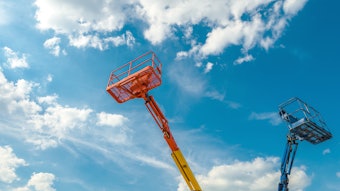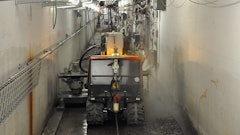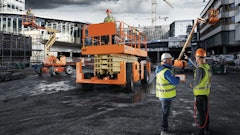
A fenced in jobsite that limits the work area can be quite a challenge to a telehandler operator. Add in cranes scattered about the site, and trucks moving in and out of the work area, and it can become a nightmare. Overcoming such challenges in order to efficiently deliver bricks, mortar and other supplies where needed requires both skill and a highly maneuverable machine.
Such have been the conditions encountered on the Delnor Hospital expansion project, situated in the burgeoning countryside of Geneva, IL, just 50 miles west of downtown Chicago. The three-story addition will add 100,000 sq. ft. of building space to the existing 313,100-sq.-ft. facility. It will house 52 private patient rooms and provide more space for outpatient and support services.
“Things get to be a zoo around this jobsite at times,” admits Tom Tokarz, foreman for J and E Duff, Inc., the masonry contractor working on the addition. “Throughout the day, many trucks are entering and leaving the jobsite, often at the same time. That makes it a real challenge for a telehandler operator to weave between the moving trucks to deliver supplies to the masons.”
Long history with telehandlers
Since 1936, J and E Duff, Inc. has been laying bricks in Chicago and the surrounding area. The company started by building Chicago-style bungalows. Today, it builds multi-residential, commercial and institutional buildings, including condominiums, churches, townhomes, schools, fire departments, shops, shopping malls, medical centers and hospitals.
Telehandlers were nonexistent when Duff’s masons mortared their first bricks into place in 1936. When they were introduced as a labor-saving device in the late 1970s, Duff was one of the first to try the new machine. The first telehandler the company bought was a Lull model. Because it proved to be so reliable and maneuverable, it is the only brand of telehandler Duff has purchased since, says Richard Lauber, president.
Over the years, the telehandler fleet has grown to 21 units, including eight of the older model 844C-42 machines, six model 644E-42s, three model 944E-42s and four model 1044C-54s. With this mix, Duff has the capability to lift loads ranging from 6,000 to 10,000 lbs. and to a maximum lift height of 54 ft.
Despite over 28 years in the construction business - the last 16 years as foreman - Tokarz has used only Lull telehandlers. He appreciates many things about them.
“The Lull’s tight turning radius sure comes in handy on a crowded jobsite like this one, and the load placement system, with its 80 in. of horizontal boom travel, really makes it easy to precisely land the loads,” says Tokarz. “And because the telehandler has a low center of gravity, it feels a lot more stable.”
The machines have also proven very reliable. “They hardly ever need repairs,” he adds.
Ron Paver, a telehandler operator for Duff and a 25-year construction industry veteran, especially likes the model 944E-42’s tight turning radius, the ergonomic layout of the controls and the side-mounted engine.
“Because of the 944E’s side-mounted engine, there is nothing to obstruct my field of vision,” he states. “I can see things out of the corner of my eyes, while keeping my eyes focused on the area directly in front of me as I am driving the telehandler. That is critical when trucks are zooming all around me, particularly when I stop at intersections to make sure it’s clear before I cross.”
Attachment versatility
With the variety of attachments offered, including a fork-mounted work platform, truss booms, material buckets, etc., the telehandlers have proven very versatile.
For example, attachments come in handy when the machine on site can’t reach a required height to deliver supplies. By using a truss boom attachment instead of the forks, Tokarz says he can gain additional working height, although it reduces the amount of weight the telehandler can safely lift.
To use the truss boom attachment, the telehandler operator simply lowers the boom to the ground. Once on the ground, the operator removes the pins securing the forks and carriage assembly to the boom, then locates the truss boom onto the telehandler boom and replaces the securing pins.
Labor savers
By the time the Delnor Hospital expansion is completed this Spring, Duff’s telehandlers will have delivered about 175,000 bricks and 3,000 concrete blocks around the congested jobsite. Based on Tokarz’s estimates, if the company didn’t have the telehandlers, he would need about twice as many workers to finish the addition within the assigned deadline. ?


























